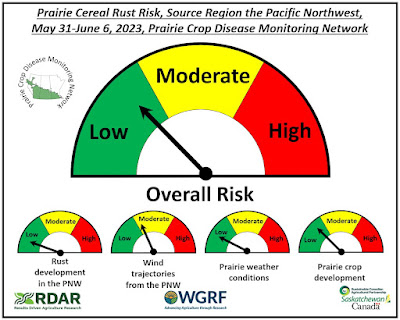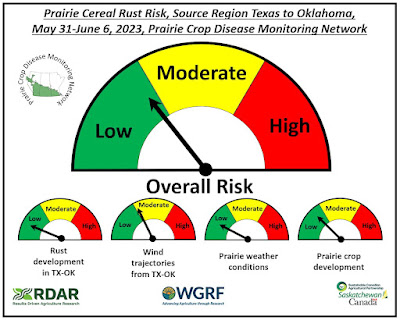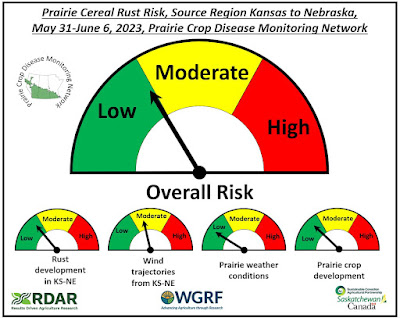The latest Prairie wind trajectory cereal rust risk report is available for download now at the following link: May 31-June 6, 2023 report.
As of the period of May 31-June 6, 2023 the overall Prairie cereal rust risk assessment and need for in-crop scouting is as follows:
Pacific Northwest – Even though there were a number of reverse wind trajectories that passed over the PNW region and into the Prairies, given limited stripe rust development in the PNW, generally dry Prairie conditions especially in western regions where most of the PNW trajectories end up, and relatively early stages of Prairie crop spring crop development, as of June 6, 2023 the risk of stripe rust appearance from the PNW is low and scouting for this disease in the Prairie region is generally not urgent.
Texas-Oklahoma corridor – Given limited leaf, stem, stripe and crown rust development in this corridor, generally dry eastern Prairie conditions and relatively early stages of Prairie crop development, as of June 6, 2023 the risk of stem, leaf, stripe, and crown rust appearance from the Texas-Oklahoma corridor is generally limited and scouting for these diseases in the Prairie region is not urgent. From May 31-June 6, 2023 there were an increased number of trajectories from the Texas to Oklahoma region to Manitoba and eastern Saskatchewan. However, with limited rust development in the Texas to Oklahoma region there is likely limited risk for the eastern Prairie region, although it may be useful to keep an eye out for rust development, especially for fields planted to susceptible varieties and winter wheat.
Kansas-Nebraska corridor – Given
limited leaf, stem, stripe and crown rust development in this corridor, generally
dry eastern Prairie conditions, and early stages of Prairie crop development, as of June 6, 2023 the risk of stem, leaf,
stripe, and crown rust appearance from the Kansas-Nebraska corridor is limited
and scouting for these diseases in the Prairies is not urgent. However, From May 31-June 6, 2023 there were
an increased number of trajectories from the Kansas to Nebraska region to
Manitoba and most regions of Saskatchewan.
Although rust development has generally been limited in the Kansas to
Nebraska region, recent reports of stripe rust in Kansas commercial fields may
be an emerging concern. In Prairie regions
with 3-7 trajectories from the Kansas to Nebraska corridor and the occurrence
of rainfall over the last week or so, farmers and consultants may consider
keeping an eye out for stripe rust development, especially in fields planted to
susceptible varieties and winter wheat.




